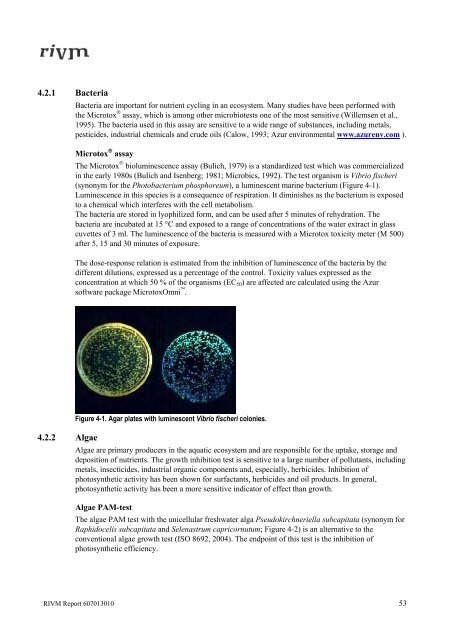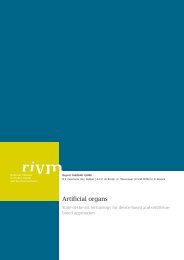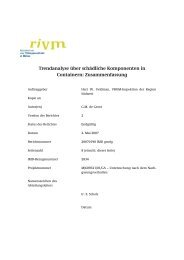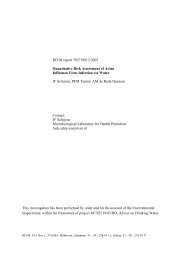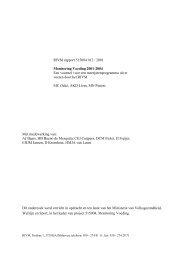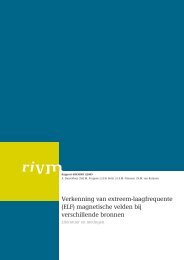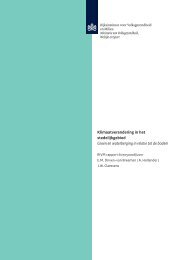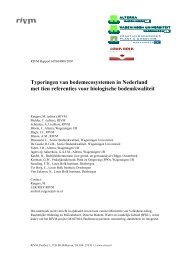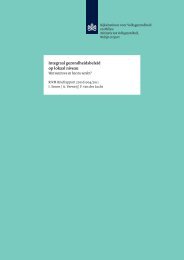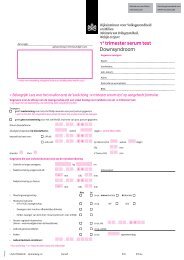Toxicity measurements in concentrated water samples - Rivm
Toxicity measurements in concentrated water samples - Rivm
Toxicity measurements in concentrated water samples - Rivm
You also want an ePaper? Increase the reach of your titles
YUMPU automatically turns print PDFs into web optimized ePapers that Google loves.
4.2.1 Bacteria<br />
Bacteria are important for nutrient cycl<strong>in</strong>g <strong>in</strong> an ecosystem. Many studies have been performed with<br />
the Microtox ® assay, which is among other microbiotests one of the most sensitive (Willemsen et al.,<br />
1995). The bacteria used <strong>in</strong> this assay are sensitive to a wide range of substances, <strong>in</strong>clud<strong>in</strong>g metals,<br />
pesticides, <strong>in</strong>dustrial chemicals and crude oils (Calow, 1993; Azur environmental www.azurenv.com ).<br />
Microtox ® assay<br />
The Microtox ® biolum<strong>in</strong>escence assay (Bulich, 1979) is a standardized test which was commercialized<br />
<strong>in</strong> the early 1980s (Bulich and Isenberg; 1981; Microbics, 1992). The test organism is Vibrio fischeri<br />
(synonym for the Photobacterium phosphoreum), a lum<strong>in</strong>escent mar<strong>in</strong>e bacterium (Figure 4-1).<br />
Lum<strong>in</strong>escence <strong>in</strong> this species is a consequence of respiration. It dim<strong>in</strong>ishes as the bacterium is exposed<br />
to a chemical which <strong>in</strong>terferes with the cell metabolism.<br />
The bacteria are stored <strong>in</strong> lyophilized form, and can be used after 5 m<strong>in</strong>utes of rehydration. The<br />
bacteria are <strong>in</strong>cubated at 15 °C and exposed to a range of concentrations of the <strong>water</strong> extract <strong>in</strong> glass<br />
cuvettes of 3 ml. The lum<strong>in</strong>escence of the bacteria is measured with a Microtox toxicity meter (M 500)<br />
after 5, 15 and 30 m<strong>in</strong>utes of exposure.<br />
The dose-response relation is estimated from the <strong>in</strong>hibition of lum<strong>in</strong>escence of the bacteria by the<br />
different dilutions, expressed as a percentage of the control. <strong>Toxicity</strong> values expressed as the<br />
concentration at which 50 % of the organisms (EC50) are affected are calculated us<strong>in</strong>g the Azur<br />
software package MicrotoxOmni .<br />
Figure 4-1. Agar plates with lum<strong>in</strong>escent Vibrio fischeri colonies.<br />
4.2.2 Algae<br />
Algae are primary producers <strong>in</strong> the aquatic ecosystem and are responsible for the uptake, storage and<br />
deposition of nutrients. The growth <strong>in</strong>hibition test is sensitive to a large number of pollutants, <strong>in</strong>clud<strong>in</strong>g<br />
metals, <strong>in</strong>secticides, <strong>in</strong>dustrial organic components and, especially, herbicides. Inhibition of<br />
photosynthetic activity has been shown for surfactants, herbicides and oil products. In general,<br />
photosynthetic activity has been a more sensitive <strong>in</strong>dicator of effect than growth.<br />
Algae PAM-test<br />
The algae PAM test with the unicellular fresh<strong>water</strong> alga Pseudokirchneriella subcapitata (synonym for<br />
Raphidocelis subcapitata and Selenastrum capricornutum; Figure 4-2) is an alternative to the<br />
conventional algae growth test (ISO 8692, 2004). The endpo<strong>in</strong>t of this test is the <strong>in</strong>hibition of<br />
photosynthetic efficiency.<br />
RIVM Report 607013010 53


